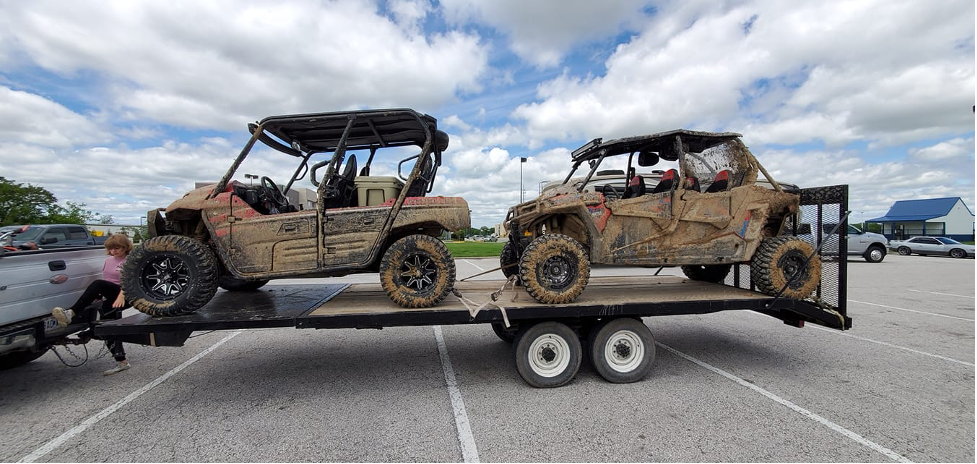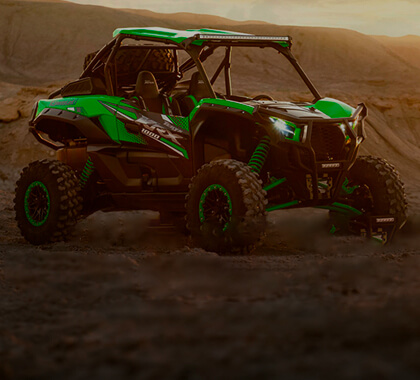How The Kawasaki Teryx Compares To Other Brands
Jan 08, 2021
If you’re like most side-by-side owners, you’ve probably done your homework vis-à-vis the various UTV manufacturers out there. After all, who wouldn’t look into specs, prices, sizes, and other features before committing to an expensive off-road 4×4? There are many types of Utility Terrain Vehicles out there, and comparing those in different classes can be like comparing apples to oranges. But within the sport side-by-side rubric, the Kawasaki Teryx is often pitted against vehicles like the Yamaha Wolverine, the Polaris RZR, the Textron Wildcat, and the Can-Am Maverick.
But before you compare UTV brands to determine the best option, you first need to ask yourself what kind of riding you’ll be doing? The machine that goes flying 30 feet in the air from one sand dune to another is different from the one that’s made to crawl through the rocks at Moab. And these machines are both different from the one you take to play around in a six-foot-deep mud hole. In any case, reliability is always important, and having a bike that doesn’t need constant repairs is a definite plus. So, how does the Kawasaki Teryx stack up?
The Kawasaki Teryx 4 Vs. The Polaris RZR 4

After you’ve identified your personal needs, you can then make a better comparison between the Teryx and other UTVs. A vehicle against which the Teryx 4 is frequently juxtaposed is the Polaris RZR 900. If you speak with folks in both camps, you’ll quickly recognize several emergent themes; the first of which being durability. Anecdotally, the Razor guys and girls seem to spend more time repairing their vehicles than the Kawasaki people do. It also appears that more Kawasaki riders report warranty items being covered than they think might not be, while RZR owners frequently complain about how almost nothing is covered. Regarding the former, there’s no good way to determine cause and effect. Instead of the Razor being an inferior machine, it could be that RZR owners are more prone to take greater risks, and therefore break their machine’s with greater regularity. It could also be that riders who choose a machine with higher horsepower are generally the type of people who drive recklessly.
In addition to being more durable, the four-seat Teryx is also much shorter than the 4-seat RZR, which makes a huge difference and shouldn’t be undervalued on either the trail or job site. The location of the engine is also different between the two vehicles. In the Kawasaki Teryx, you’re sitting directly next to the motor, and this makes the vehicle more stable with better weight distribution. The location of the Teryx engine, however, does make the cab hotter and more noisy.
If you get a factory-fresh Teryx straight from the dealership floor, you might be a bit underwhelmed in terms of power. This is due in large part to Kawasaki tuning down the Teryx electronically. With the help of an aftermarket power box, programmer, or ECU tuner, though, you can make the Kawasaki Teryx come alive!
When you compare the price of an RZR 4 900 with a Kawasaki Teryx 4, you’ll find that the latter costs around $4,000 less. On top of that, the Teryx also comes with a three year warranty! One caveat regarding the stock Kawasaki Teryx, however, is the suspension. But if that’s a problem, you can take your savings and re-invest them into shock upgrades.
There are several aftermarket options out there for Kawasaki Teryx shocks. You can go with Vikings, Bandits, or QA1s, which are all really good upgrades over stock. Many riders go with a 5-3/4” stroke front shock and a 6-3/4” stroke rear shock, as these lengths are close to the factory settings yet still allow for more shock travel. A complete Kawasaki Teryx shock set-up could set you back more than a grand, but even if it’s double that, you’ll still come out ahead as far as price goes. Plus, if you get double adjustable shocks (meaning that you can fine-tune both the compression and the rebound individually), you’ll be able to lift your Teryx to the desired ride height without affecting the plushness of your ride!
The Kawasaki Teryx Vs. The Can-Am Maverick

Both RZR and Can-Am UTVs are different from the Teryx in terms of cab space, and switching back and forth between them often feels strange — especially with Can-Am machines because of the low seating position. The Can-Am Maverick X3 as well as most other 4-seater Can-Ams are over 13ft long, so they do offer more legroom. Because of this, however, they aren’t the handiest of machines to work out of. In tight wooded trails, rocky terrain, and technical mountainous routes, the Teryx will keep up with a Maverick no problem. But get into some wide open stretches or go to the desert and you’ll be left in the dust behind the higher-horsepower Can-Am Maverick.
As we mentioned earlier with the RZR, the stock Teryx suspension isn’t the greatest, and it can’t compete with the Can-Am Maverick suspension. A Maverick owner will fly through whoops and ruts as if they weren’t even there. Meanwhile, a stock Teryx owner will have to negotiate every inch in a manner that won’t shatter their spine. Due to its size and ability to crawl, however, the Teryx will take you to parts of the woods that a 4-seat Maverick owner will never see.
In Summary

Budgetary constraints, dealership incentives, and personal needs all play a role in the UTV purchasing decision. But these are just a few of the factors that existing and potential Teryx owners must consider. Many current Teryx owners have become disillusioned over the years, waiting and waiting for Kawasaki to bring a new Teryx / sport model to the industry. But even though the Teryx may be lacking on the power side, it performs great on the trails, hills, rocks, and mud; plus, the reliability of the Teryx is outstanding!
If price is an issue, many side-by-side owners buy salvaged machines and then fix them up with the necessary repairs and replacement parts. Although you have to pay cash (and sometimes a yearly subscription), sites like www.iaai.com or www.copart.com offer great deals for those who are willing to commit the time and energy to a wrecked fixer-upper. At the end of the day, though, you’ve gotta do what feels right for you. Get out there, test drive as many UTV brands as possible, and make a determination based on your wants, needs, and personal situation!



